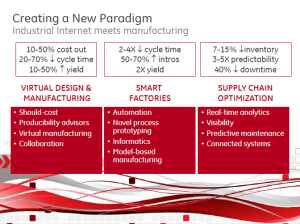Several months ago I predicted that Amazon’s Echo might become the IoT’s killer device, primarily because it is voice activated. It appears that prediction is coming true, which should give the entire consumer IoT a boost because Amazon is also providing a soup-to-nuts approach of devices, platform, and storage meeting a wide range of IoT needs, which puts a real emphasis on customer ease of use.
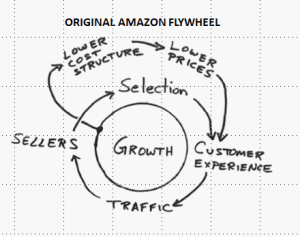
Amazon Flywheel
Even more exciting from my perspective, is that part of that success may be due to something I was unaware of that fits beautifully with my “circular enterprise ” vision of the IoT: Jeff Bezos’ back-of-the-envelope sketch when he founded the behemoth, of what he called the “Amazon Flywheel,” It’s as good an illustration as I can think of regarding my vision of circular organizations and strategy — not to mention their profitability!
Even the WSJ got on board with an article about Amazon in regard to the IoT, although it focused solely on Echo and its voice app, Alexa, and ignored the all-important mechanics that it also provides.
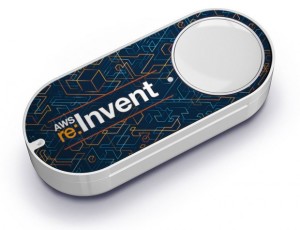
Amazon IoT Button
The latest step in fleshing out the ecosystem was the announcement earlier this month of the AWS IoT Button, modeled on its highly successful DASH button, which allows ordering more than 100 different consumer products from Amazon by simply pressing the button (the “button” is also now also available in virtual form as a software service, so that a number of products, such as a Whirlpool smart washing machine, will determine that the owner is running low on detergent, and automatically send an alert to her phone. A simple touch on the phone triggers a refill order from Amazon). The 1st edition IoT button sold out instantly!
It joins a comprehensive, and growing, package of IoT devices and services from Amazon that I suspect will quickly make it the platform of choice for the consumer IoT:
- AWS IoT Platform. As you probably know, Amazon has become the 10-ton gorilla of the cloud storage field, through Amazon Web Services, the largest cloud firm. But you might not know that last year it also launched The AWS IoT Platform, built partially on the 2lemtery IoT platform that it had bought earlier.
- AWS IoT Hardware Developer Program “that allows companies to build reordering buttons directly into their own hardware. Listed on that page are partners such as Whirlpool (reorder laundry supplies), Brother (ink and toner), Brita (water filters) and Quirky (which is launching a line of appliances including a fancy pourver coffee machine). An Amazon spokesman says the first Dashenabled devices will start showing up in the fall.“
- Home Services is an on-demand service in selected major cities for local installation and repair of IoT devices. Clicks and bricks!
- Its $100M Alexa Fund, “to fuel voice technology innovation. We believe experiences designed around the human voice will fundamentally improve the way people use technology” (amen, brother…) It has “invested in companies like homesecurity firm Scout Security Inc. and wireless doorbell maker Bot Home Automation Inc,”
You get the idea: this is a conplete solution, from platform to cloud storage to devices to highly-personal (voice) interface.
And there’s that matter of the Amazon Flywheel that I mentioned previously. I came across it in researching this post, in a blog post by John Rossman in which he referred to the Flywheel as “a long-tested systems dynamic view of Amazon’s core retail and marketplace business” (music to my ears: it was exposure to Jay Forrester & Peter Senge’s work on systems dynamics that first got me interested in cyclical processes, back in the late ’80s). He explains how this continuous loop leads to dynamic growth, especially in Amazon’s infrastructure offerings:
“When thinking through an IoT solution, what is most obvious is the end device. But this is the classic “tip of the iceberg” in creating an end-to-end solutions. The IoT Value Chain is defined by devices, connectivity, big data, algorithms, actions, and connection to the rest of the enterprise. As more and more IoT Devices get introduced, a greater amount of data (both big and small) is generated. This data, once integrated with algorithms create a greater overall customer IoT impact generating more demand for more devices. All of these devices and services can be hosted on AWS and utilize their infrastructure capabilities leading to greater growth of the infrastructure. At this point, the loop looks familiar: infrastructure growth leads to lower costs, which means more services and companies rely on the infrastructure locking into a cycle of higher customer impact. Amazon Web Services has several existing IoT enabling products include AWS Redshift, AWS Kinesis, AWS Machine Learning and recent acquisition of 2lemetry show that the big bet for Amazon is not in creating devices for its retail business, but in providing cloud infrastructure and software to thousands of companies needing to build IoT devices and capabilities. This is the AWS IoT flywheel and the real business in IoT for Amazon.”
Yeah, but the bucks that it will get from Dash orders and from Echo ain’t shabby either. Keep up that cyclical thinking, Mr. Bezos!
PS: this also makes me more and more confident that Echo and Alexis can be the key to the robust “SmartAging” approach that I visualize because its use of voice will help seniors, especially the tech-averse, manage their health AND their homes and allow them to age in place healthily! Gonna have to get me some partners to go after Alexa Fund backing…

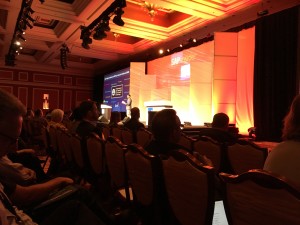
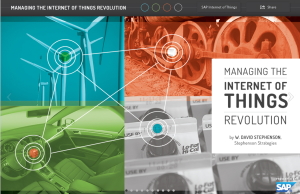 This is an issue that I first visited with my “
This is an issue that I first visited with my “